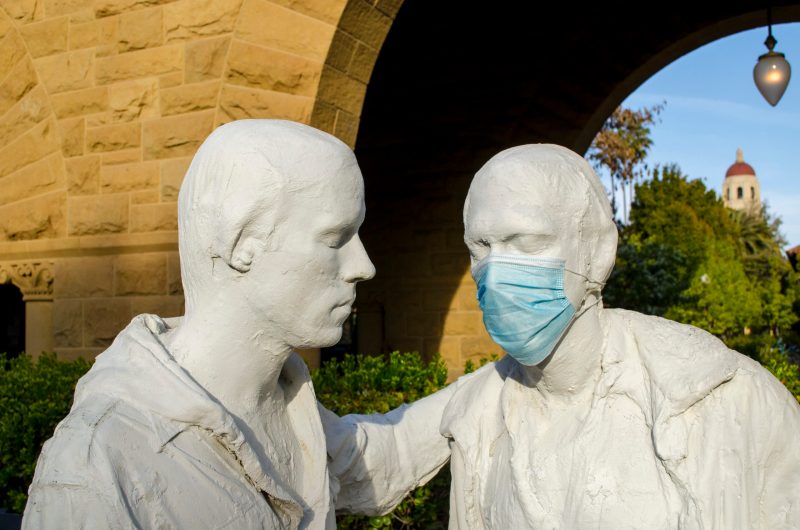Residents in rural Bangladesh who wore surgical masks regularly when around others and received consistent education regarding the proper wearing of face masks were roughly 11% less likely to develop COVID-19 symptoms than those who did not, Stanford and UC Berkeley medical researchers and Yale University economists found in a study released on Wednesday. The researchers recommend that mask-wearing practices be scaled up in lower- and middle-income countries to complement vaccine distribution efforts and keep populations safe.
The pre-print of the study, conducted under a large-scale randomized control trial, was published online by Innovations for Poverty Action on Sept. 1. The researchers found that consistent educational intervention leads more people to wear masks over their nose and mouth in public settings, thereby reducing the spread of COVID-19. The study’s key findings also included evidence for the superior filtration efficiency of surgical masks compared to that of cloth masks.
Studying nearly 350,000 people in 600 Bangladeshi villages from Nov. 2020 to Apr. 2021, the research team utilized a set of four interventions on 300 randomly selected intervention villages, totaling around 178,000 people. These actions, called the “NORM model,” included free mask distribution, providing information on correct mask-wearing practices, public reinforcement and mask-wearing endorsement by trusted public and religious leaders.
Ultimately, the Stanford-Berkeley-Yale group discovered a series of statistical shifts pointing to concrete proof that masks, and in particular surgical masks, provide protection against the community spread of COVID-19.
Compared with the 300 control villages, the villages with NORM intervention experienced a 29 percent increase of mask usage (from 13 percent to 42 percent) and reduced the number of people with symptomatic COVID-19 seroprevalence (confirmed by bloodwork) by nine percent. Infections among people 60 years and older were reduced by 35 percent.
“This study does provide definitive, systematic evidence that masks do reduce COVID-19,” lead author and Stanford infectious disease fellow Ashley Styczynski said.
Styczynski added that she believes the data gathered is likely an underestimate of the impact of effective surgical masks. She used three main factors to explain her reasoning. First, Styczynski said, the study never achieved universal masking, reaching a peak of only 43% of the intervention population wearing masks reguarly. Had a higher percentage of the population committed to consistent mask-wearing, there could have been a higher benefit. Second, Styczynski cited the fact that the trials were conducted during a time of lower transmission rates, rather than during a major surge of COVID-19 cases. Third, she said that only one-third of symptomatic individuals consented to undergo blood sampling to determine seropositivity (testing positive for antibodies), leaving the researchers with a smaller group of subjects.
One of the researchers’ early concerns, according to senior author and Stanford professor of medicine Stephen Luby, was that although existing studies showed that people who wear masks are less likely to develop COVID-19, someone who consistently wears a mask may also be more likely to practice additional precautionary behaviors, such as maintaining a safe distance from others in public spaces. How, then, could the researchers isolate the mask-wearing variable, and remove other conflating ones?
To address this problem, the researchers thought carefully about the location of the study. Given the density of Bangladesh — the population’s size is half of that of the U.S., despite its geographical area being about the same size as Iowa — physical distancing was usually not practical for study participants, making for an especially notable reliance on other methods of prevention.
Luby, who lived in Pakistan for five years and Bangladesh for eight, drew from personal experience to highlight how poorer, more densely populated countries often bear a heavier burden of disease. Vaccination rates in these nations have consistently fallen behind those of wealthier nations, to which about 80% of COVID-19 vaccine doses have been administered. Of the 27 lowest-income countries around the globe, less than 2% of residents have received their first dose of the vaccine, according to Our World in Data.
Luby and his team sought to design a randomized controlled trial “because results of these types of studies tend to be widely persuasive,” he wrote in an email to The Daily.
“The increased use of face masks demonstrated a more generalizable biological finding — that is, if you can increase the number of people who wear masks with high filtration efficiency, then you can reduce the number of people who develop COVID-19.”
The researchers also tested the outcomes of cloth masks versus surgical masks. In agreement with background lab studies that analyzed the filtration efficiencies of various materials, the team found that across every scenario, surgical masks outperformed cloth masks, according to Styczynski.
“I think moving forward, what this shows us is that a more effective mask provides more effective protection,” Styczynski said. “As we have new variants emerge, mask-wearing is likely to continue to be a critical adjunct to vaccines to prevent community transmission and to really protect high-risk populations.”
According to lead author and UC Berkeley environmental health sciences professor Laura Kwong M.S. ’15 Ph.D. ’19, surgical masks can be washed and still maintain a higher filtration efficiency than cloth masks.
“High-quality surgical masks have filtration efficiencies close to 90% and can be much more comfortable to breathe through,” Kwong wrote in an email to The Daily. “They are also 8 to ten times cheaper than cloth masks.”
Styczynski added that the cost-effectiveness of the mask-wearing strategy makes it one that can be easily scaled to low- and middle-income countries across the globe.
“This is a strong tool that we can now use to help promote policies as we roll them out,” Styczynski said.
The research team is beginning their expanded roll-out efforts. According to Kwong, the group has begun working with governments and NGOs in Bangladesh, India, Pakistan and Nepal, and are also introducing the NORM method to governments and NGOs in Zambia, Ghana and Senegal.
